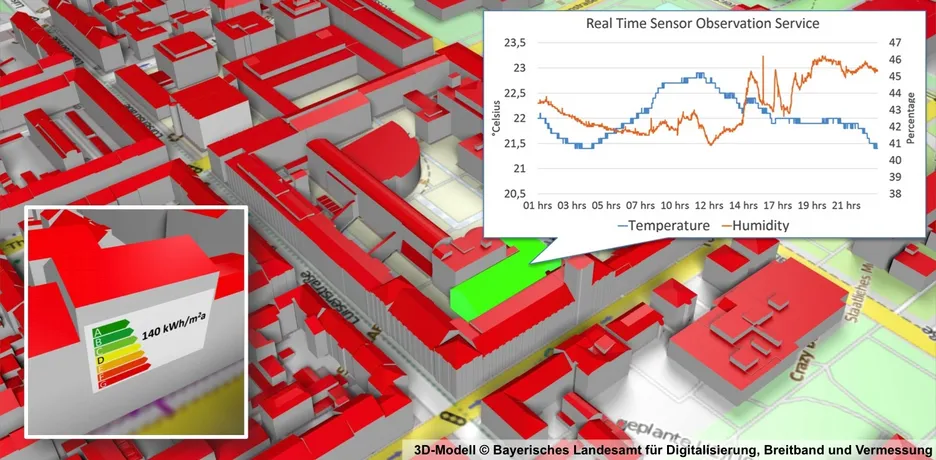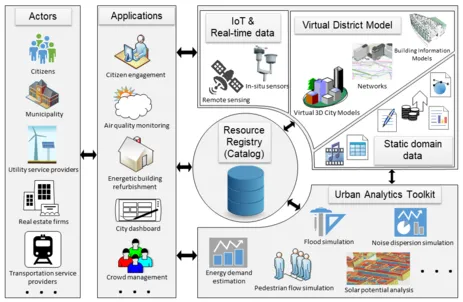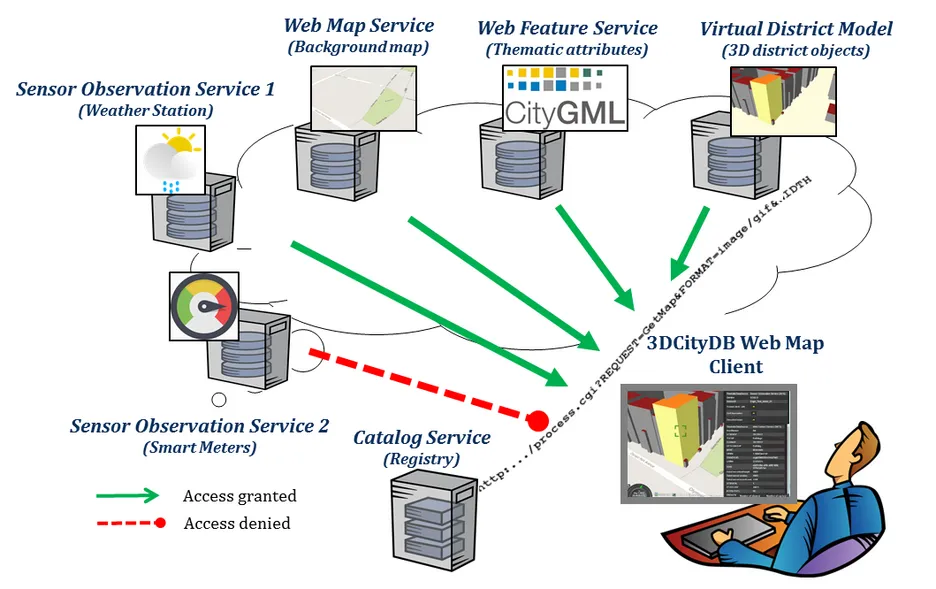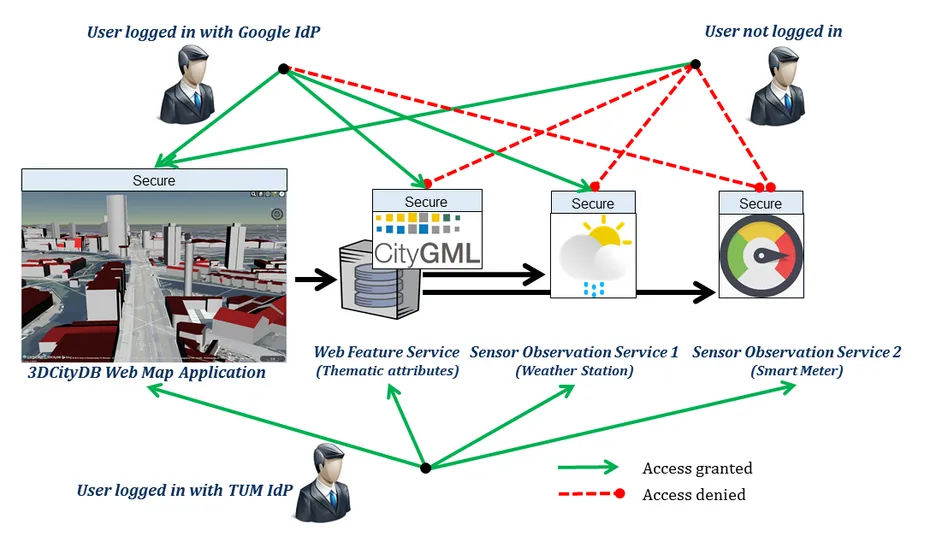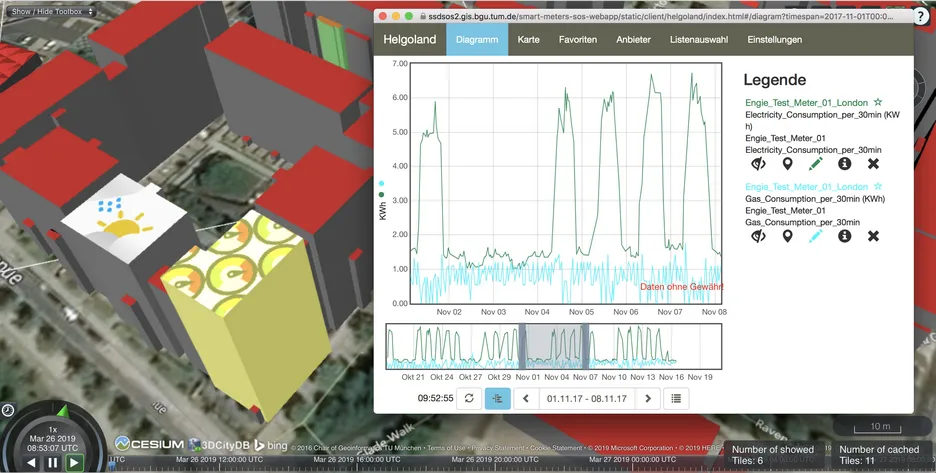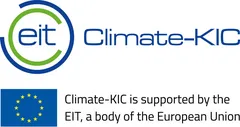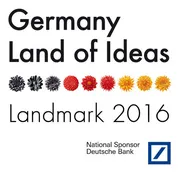More than 50% of the world population is living in cities today and the number is further increasing. No matter if looking at environmental noise, air quality and particulate matter, energy usage and production, or traffic flows - in order to achieve or maintain a high quality of living in cities, municipalities and companies must take into account many different concerns simultaneously. The concept "Smart District Data Infrastructure" (SDDI) provides planners with the necessary set of flexible tools. Entire cities or just city districts are represented by 3D virtual city models which are linked with dynamic data, for example, on the traffic density or energy consumption. These models are used for monitoring and evaluation of the current situation, and especially for simulations of future developments and an early impact analysis.
Project description
The SDDI has a modular structure and defines an organisational and technical framework consisting of actors, applications, sensors, an urban analytics toolkit, and a virtual district model. Actors are citizens and the city administration, but can also be other stakeholders like public transport services, utility service providers, and real estate firms. Sensors comprise local weather and climate stations, regional weather radar, smart meters for energy, gas, and water consumption, video cameras, and traffic sensors. Urban analytic tools are software components that, for example, estimate the energy demands or potentials of solar energy production for all buildings, simulate road traffic and pedestrian flows, or perform noise propagation or flooding simulations. The SDDI is based on Open Standards and links systems of different manufacturers in a non-proprietary and extensible way.
What makes the SDDI framework unique compared to others within the field of Smart Cities is the fact that all information, sensors, and applications are located within a semantic 3D city model. The latter is a virtual representation of the physical reality of the district. It consists of the most relevant objects like buildings, streets, vegetation, water bodies, and networks. The 3D model is based on the international standard CityGML and does not only serve for neat visualizations - it is an information hub and essential foundation for most simulations and analytic tools. Within this virtual district model, for example, the energy demands of buildings can be put in relation to their physical conditions and their socio-economic key performance indicators. This way, the impact of planned urban redevelopment projects on the different thematic fields like the environment, mobility, energy, and social affairs can be investigated at the same time.
Adoption throughout Europe
The SDDI has been developed to a large extent within the flagship project "Smart Sustainable Districts" (SSD) funded by the European research body Climate-KIC. The SSD project provides methods and tools to support urban redevelopment on the district scale. Major concerns are (among others) the reduction of emissions, increase of energy efficiency, usage of renewable energies, and the general improvement of the quality of living in cities. SDDI is being employed already in three ongoing large urban redevelopment projects:
- London, Queen Elizabeth Olympic Park: This project is on the transformation of the district where the Olympic games 2012 took place to a new structure with mixed residential, recreational, and commercial usage.
- Paris, Docks de St. Ouen: Brownfield development of a new district with residential and commercial usage on the territory of the former Paris docks next to the Seine river.
- Berlin, Green Moabit: The focus lies on the energetic retrofitting of a large number of buildings and concepts for a more sustainable water management.
Due to the use of Open Standards most of the analysis tools and applications which are being developed for a specific district can be also employed by the other districts.
Securing the SDDI Framework - Demonstrator Application
The SDDI Security Demonstrator Application, developed by the Chair of Geoinformatics and Secure Dimension GmbH, presents a novel approach of securing distributed applications and web services being used in Smart City scenarios. The application has been realized for the district Queen Elizabeth Olympic Park, London as a part of the SDDI project.
The newly introduced concept establishes proper authorization and authentication to allow privacy, security and controlled access to all stakeholders and the respective components. The implementation combines the use of state-of-the-art concepts such as OAuth2 access tokens, OpenID Connect user claims and Security Assertion Markup Language (SAML) based Single-Sign-On (SSO) authentication. The application is conformant to the EU General Data Protection Regulation (GDPR).
Please find below important links:
Application Demonstration Link
Application Server
Authorization Server
Components used in the Demonstrator
- Virtual District Model based on the CityGML standard. It comprises of semantic 3D building and street models with spatial and thematic information stored in a 3D geodatabase.
- Web Feature Service allowing users to retrieve as well as modify objects from the Virtual District Model stored in the 3D geodatabases using interoperable interfaces.
- Sensor Observation Service 1 retrieving real-time observations from a weather station installed in the park. The weather station records properties such as temperature, humidity, wind speed etc.
- Sensor Observation Service 2 retrieving real-time observations from Smart Meters installed in important buildings such as stadium and aquatic center. The Smart Meters are managed within a proprietary platform of the company Engie and record electricity and gas consumptions for the buildings.
- 3DCityDB Web Map Client is a web-based front-end for the 3D City Database for 3D visualization and interactive exploration of large semantic 3D city models in CityGML.
Demonstrator Objectives
The demonstrator provides
- security layers to all of the resources, so that no resource can be accessed without proper authentication and authorization,
- federated login and Single-Sign-On access using different Identity Providers. This is demonstrated by showing that users can login using academic identity federations (such as eduGAIN service supporting approximately 2758 university identity providers worldwide) and public accounts (such as Google accounts) to all the secured resources hosted on distributed systems without repetitive logins, and
- access control to all the secured resources. Users can login via two different classes of identity providers: (i) a valid public account (e.g. Google) and (ii) a valid academic organization account linked to eduGAIN. In the scenario, if a user is not logged in, he/she can browse/view the 3D models but cannot connect to any further resource. Users logged in using the Google Identity Provider can access all resources except Sensor Observation Service 2 for Smart Meters, while users logged in using an eduGAIN based research organization's Identity Provider will be able to access all resources.
Below is a screenshot from the application visualizing a highlighted building (where Smart Meter is installed) and the timeseries observation graph for one week (retrieved from Sensor Observation Service for the Smart Meter).
Project partners
In the project Smart Sustainable Districts in general
- Imperial College London, Centre for Process Systems Engineering, Prof. Nilay Shah
- Technische Universität Berlin, CHORA City & Energy, Prof. Raoul Bunschoten
- University of Utrecht
- Chalmers University of Technology
- Utrecht Sustainability Institute (USI)
- Institute for Sustainability London
- Aria
- TNO
In the district London, Queen Elizabeth Olympic Park (QEOP)
- Imperial College London, Centre for Process Systems Engineering, Prof. Nilay Shah, Dr. Chris Mazur
- University College London, The Bartlett Centre for Advanced Spatial Analysis (CASA), Prof. Andrew Hudson-Smith, Oliver Dawkins
- London Legacy Development Corporation (LLDC), Jim Wood, Ben Edmonds
- Intel Labs Europe, ICRI Cities, Dr. Evangelos Theodoridis, Dr. Mo Haghighi
- Engie
In the district Paris, Docks de St. Ouen (NUM-DOCKS)
- Aria, Denis Morin, Corinne Krzyzamiak
- Sequano
In the district Berlin Moabit
- Technische Universität Berlin, CHORA City & Energy, Prof. Raoul Bunschoten, Nadine Kuhla von Bergmann, Daniel Rigamonti
Award in the contest "Germany - Land of Ideas"
As one of 100 winners from about 1000 candidates the project has been awarded "Landmarks in the Land of Ideas" 2016. The goal of the "Germany – Land of Ideas" initiative and Deutsche Bank is to make innovations visible in Germany and abroad and to strengthen the economic potential and sustainability of Germany as a location. This year, in 2016, the competition "CommUnityInnovation – a model for success" is awarding projects that show the added value and potential of joint action, whether in business partnering, scientific networks, or neighbourhood initiatives.
